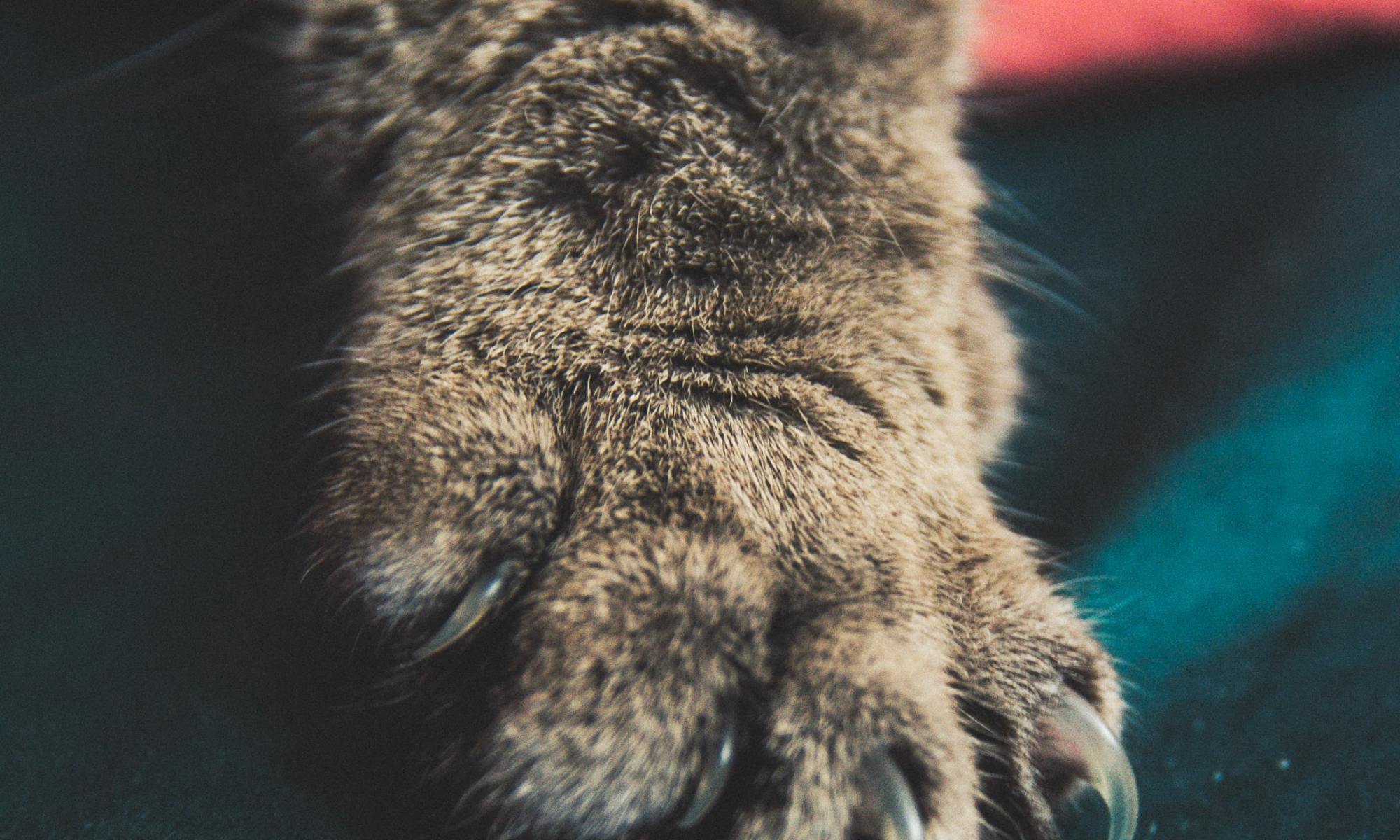
Today I want to focus on an all too common procedure that is requested at veterinary offices. One that can come with much headache for both owner and veterinary staff alike… that is, the toenail trim. It is added most commonly as an after-thought to a visit. “Oh, and while she’s here, could you cut her nails?” Or, “He’s an absolute nightmare at home about it, could you try to cut his nails if he’ll let you?” These are all too common phrases we hear day in and day out. It doesn’t have to be a stressful, time consuming procedure though! Let’s explore nail trims a little.
The toe nail, or the claw as it is called more officially, can be a frustrating normal part of your furry friend’s anatomy. The nails are, of course, supposed to be present and are a natural part of our pet’s lives. Toenails play an important role for exploring the environment, digging, climbing, and balancing while running. However, like with people, the longer the nail the larger the potential for problems, such as broken nails or even broken fingers (digits).
Ultimately, nail trims are an important part of the general care of your furry friend. Patients with a normal gait and high activity levels often do not need their nails to be cut. However, some dogs, do not get enough normal contact against their nail. This may be secondary to a lack of abrasive surface to contact the nails, or may be a result of changes that develop to their gait as they age. As a result of these changes to their lifestyle, your pets’ nails may eventually need to be cut.
I’m sure we’ve all experienced that it is more than possible to cut a nail too short which leads to pain and possibly bleeding. Similarly, with our furry friends, like dogs and cats (and your smaller mammals too like rabbits or guinea pigs), it is very possible to cut too short. If you accidentally take too much of the claw off you will hit the sensitive portion of the nail, colloquially referred to as, the quick. This area houses nerves and blood supply, so when cut it is very sensitive and will often bleed extensively- sometimes to the point of needing a bandage.
Now that I’ve gotten through the scary stuff, nail trims are absolutely something that can and should be done at home. A vast majority of animals will tolerate this procedure, especially if you begin working with them when they are young. All it takes is a little patience, a lot of treats, and a gentle hand.
Trust me, you can do it!
Let’s start with cats. Cats will absolutely tolerate nail trimming at home, and frequently human nail cutters will work on them because their nails tend to be thinner than dogs’. The best place to start with your cat is to get them used to you handling and touching their feet and nails. This is often easiest to do when they are sleeping on their beds, the couch, your lap, or wherever they choose to spend their downtime. This can be made more positive for them by adding in their favorite treats; although some cats will be relaxed enough that handling of the feet and nails will not even wake them up. In fact, growing up, my mom and I used to cut our cat’s nails while she slept in one of our laps. She didn’t care at all.
Once you have gotten your cat familiar with handling their feet it is time to introduce the nail trimmers themselves. This is easiest by allowing them to sniff or be near the nail trimmers without any consequence. Essentially, bring the nail trimmers close to them and don’t cut the nails until they have had a few visits with the nail trimmers themselves. Then finally you can work up to putting the nail into the nail trimmer and applying gentle pressure, again ideally not fully cutting the nail. This will allow them to get used to a little pressure over their nails which can be alarming to some patients. Remember, the actual cutting of the nail will be an entirely new experience to your pet. They will not generally be able to rationalize what the feeling is, so it is our job to make it positive!
Finally, after slowly working through these steps over at least several days, you can begin to cut the nails themselves. Many patients will have nails that are somewhat transparent which will allow you to see the quick as a pink structure within the nail. It is important to note that even if you can visualize a pink structure through the nail you can not necessarily cut all the way down to it. The sensitive nerves and vessels may extend beyond this. Instead, begin by cutting off the very tip of the nail and potentially a little farther. You want to avoid at all costs hitting the sensitive portion of the nail, especially in the first couple of tries as this may make your pet averse to the whole process. Be sure to give your kitty rewards as you go. Consistent and constant rewards will make the procedure go even smoother.
Now, this process is going to be very similar for your puppies or adult dogs. The logistics might be a little trickier; however, as most dogs’ nails are going to be much too thick for a human nail trimmer. You can buy dog specific cutters at your local pet store or online. The overall process is going to be the same; keep your dog happy and well rewarded during these procedures. Always abide by the rule that too little is far better than too much when cutting nails. Some dogs, and cats too, will have black nails which will make it very tricky to estimate where the quick is. So, again, be sure to stay further from the base of the nail when you cut so you don’t hurt your little friend.
We are very fortunate that we have a variety of resources available to help learn the technique of nail trims. There are many YouTube videos out there now that you can watch. You can also ask for your veterinarian or veterinary technician to show you how to start this process while you are in the clinic for vaccines or other procedures. We show many new puppy or kitten parents how to cut nails on one of their first vaccine appointments. This helps them to start the process early.
I believe that all patients have the ability to be trained at home to have their nails cut in a low stress manner for everybody involved. Sometimes patients are adopted later in life and are maybe less amenable to training; or perhaps, it does not fit into your schedule at this time. If you are unable to train your pet for nail trims at home, they can still be performed at the veterinary clinic or at the groomer. Unfortunately, the veterinary clinic tends to be a more stressful place to begin with. So, sometimes patients require sedation or other restraint which can add to their stress level. This makes for a fairly miserable experience both for them as well as for you as the owner. Additionally, believe it or not, the veterinary staff isn’t particularly fond of having to sedate and monitor patients just to cut their nails.
Of course, inconvenience to staff is not the primary reason to try to do this at home. The largest benefit is to the patient themselves. It makes for a positive grooming and bonding experience at home with you, their owner, rather than a stressful car trip to the veterinary office where they may need to be restrained, muzzled, or sedated for it. All veterinary clinics will seek to do this procedure in the lowest stress fashion, but they must do what is safest for them.
Finally, before I wrap up, it is worth noting that all patients have the potential to become agitated or defensive if they are scared or hurt. So, it is worth teaming up with a friend of family member until you can see how your furry friend reacts to nail trims. This precaution will help prevent you from getting bitten or scratched should your pet not tolerate this.



Thanks! This is great information, as always.
LikeLike